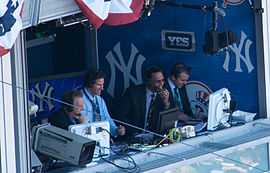Sports commentator
.jpg)
In sports broadcasting, a sports commentator (also known as sports announcer, sportscaster, or play-by-play announcer) gives a running commentary of a game or event in real time, usually during a live broadcast, traditionally delivered in the historical present tense. The comments are normally a voiceover, with the sounds of the action and spectators also heard in the background. In the case of television commentary, the commentators are on screen rarely if at all during the event (although they may appear on camera at the start or near the end of the broadcast).
Types of commentators
Main/Play-by-play commentator
The main commentator, also called the play-by-play announcer or commentator in North America, or lap-by-lap commentator in the case of motorsports coverage, is the primary speaker on the broadcast. They are valued for their articulateness and for their ability to describe each play or event of an often fast-moving sporting event. Because of their skills, some commentators like Al Michaels in the U.S. and David Coleman in the UK may have careers in which they call several different sports at one time or another. Other main commentators may, however, only call one sport.
Analyst/Color commentator
The analyst or color commentator provides expert analysis and background information, such as statistics, strategy on the teams and athletes, and occasionally anecdotes or light humor. They are usually former athletes or coaches in their respective sports, although there are some exceptions.
The term "color" refers to levity and insight provided by analyst. The most common format for a sports broadcast is to have an analyst/color commentator work alongside the main/play-by-play announcer.[1][2][3] An example is NBC Sunday Night Football in the United States, which is called by color commentator Cris Collinsworth, a former American football receiver, and play-by-play commentator Al Michaels, a professional announcer. In the United Kingdom however there is a much less distinct division between play-by-play and color commentary, although two-man commentary teams usually feature an enthusiast with formal journalistic training but little or no competitive experience leading the commentary, and an expert former (or current) competitor following up with analysis or summary. There are however exceptions to this—all of the United Kingdom's major cricket and snooker commentators are former professionals in their sports, while the legendary Formula One racing commentator Murray Walker had no formal journalistic training and only limited racing experience of his own.
Although the combination of a play-by-play announcer and a color commentator is standard as of 2014, in the past it was much more common for a broadcast to have no analysts and just have a single play-by-play announcer to work alone. Vin Scully, longtime announcer for the Brooklyn/Los Angeles Dodgers baseball team, is one of few examples of this practice still existing today.
Sideline reporter
A sideline reporter assists a sports broadcasting crew with sideline coverage of the playing field or court. The sideline reporter typically makes live updates on injuries and breaking news or conducts player interviews while players are on the field or court because the play-by-play broadcaster and color commentator must remain in their broadcast booth. Sideline reporters are often granted inside information about an important update, such as injury, because they have the credentials necessary to do so. In case of big events, teams consisting of many sideline reporters are placed strategically so that the main commentator has many sources to turn to (for example some sideline reporters could be stationed in the dressing room area while others could be between the respective team benches).
Sports presenter/studio host
In British sports broadcasting, the presenter of a sports broadcast is usually distinct from the commentator, and often based in a remote broadcast television studio away from the sports venue. In North America, the on-air personality based in the studio is called the studio host. During their shows, the presenter/studio host may be joined by additional analysts or pundits, especially when showing highlights of various other matches.
Sportscaster
In North American English, sportscaster is a general term for any type of commentator in a sports broadcast. It may also refer to a sports talk show host or a newscaster covering sports news.
United States of America

While sports broadcasts took place from 1912, Florent Gibson of the Pittsburg Star newspaper broadcast the first sports commentary in April 1921, covering the fight between Johnny Ray and Johnny "Hutch" Dundee at the Motor Square Garden, Pittsburgh.[4]
In the United States nearly all professional sports teams, most collegiate teams — as well as a dwindling number of high schools — have their own sports commentators, who are usually recognized as the voice of the team on radio broadcasts and are often identified as part of the team like the players and the coaches. In addition, television networks and cable channels will have their own stable of play-by-play announcers who work with various teams - like Michael Kay from YES's New York Yankees baseball network or Mike Breen for New York Knicks basketball on MSG.
As of 2015 women are integrated into sportscasting. In the late 1970s and into the 1980s, broadcasters like Anne Doyle pioneered the entry of women into all aspects of sports coverage.[5] A breakthrough came in 1978, when a federal court mandated allowing a female reporter into a Major League Baseball locker room.[6]
See also
| Look up sportscaster in Wiktionary, the free dictionary. |
| Wikimedia Commons has media related to sports commentators. |
References
- ↑ http://inklingmedia.net/2012/05/02/color-commentary-and-play-by-play-a-well-rounded-approach-to-facebook/#.Uk8WfhzN63Y
- ↑ http://everydaylife.globalpost.com/color-commentator-12656.html
- ↑ http://www.sportsideo.com/blog/johnlund1120/the-business-ofsports/baseball_basketball_football/the-top-three-keys-for-becoming-a-color-commentator-1681.html
- ↑ Patterson, Ted (2002). The Golden Voices of Baseball. Sports Publishing LLC. p. 12. ISBN 1-58261-498-9.
- ↑ Hilaire, Chris St.; Padwa, Lynette (2010-09-07). 27 Powers of Persuasion: Simple Strategies to Seduce Audiences & Win Allies. Penguin. pp. 26–. ISBN 978-0-7352-0451-5. Retrieved 3 July 2011.
- ↑ "Constance Baker Motley (1921–2005)". Brown@50 – Fulfilling the Promise. Howard University School of Law.
External links
- Sportcaster Chronicles – Internet radio show in which John Lewis interviews leading American sports announcers.
| ||||||||||